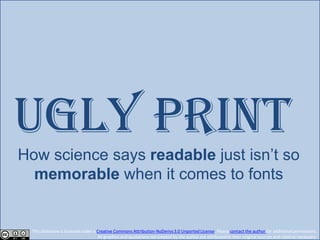
Ugly Print: How science says READABLE just isn't so MEMORABLE when it comes to fonts.
- 1. UGLY print How science says readable just isn’t so memorable when it comes to fonts This slideshow is licensed under a Creative Commons Attribution-NoDerivs 3.0 Unported License. Please contact the author for additional permissions. All graphics and quotations not created by the author are attributed to their original sources and cited as necessary.
- 2. A few years ago, I watched this film about typeface. It explained the origins of a font known as “Helvetica” (Arial to Windows users) It might sound dull, but I found it fascinating.
- 3. So, the idea of Helvetica is that it’s supposed to be a nice, neutral face. You can use it on street sights, menus, catalogs, documents, logos, presentations – anything you like, really. It’s a clean, all-purpose font.
- 4. Helvetica Image source: HelveticaFanatic (Flickr.com) Used Under Creative Commons License.
- 5. Helvetica Image source: HelveticaFanatic (Flickr.com) Used Under Creative Commons License.
- 6. Helvetica ...you get the idea. Image source: HelveticaFanatic (Flickr.com) Used Under Creative Commons License.
- 7. But this recently published study from the journal Cognition suggests that easily-read fonts have a big drawback -- -- the information they supply is a lot harder for readers to remember.
- 8. It’s not exactly a surprising finding. Human beings are highly visual creatures. Our brains process images long before they process words. That’s why the font we use conveys meaning no matter what the words say. Image source: HellsGeriatiric (Flickr.com) Used Under Creative Commons License.
- 9. Don’t believe me? Let’s try some examples. Image source: HellsGeriatiric (Flickr.com) Used Under Creative Commons License.
- 10. If I told you a child had made this slide, do you think you’d be more likely to believe me… Image source: HellsGeriatiric (Flickr.com) Used Under Creative Commons License.
- 11. …than you might if I told you that a child made this slide? Image source: HellsGeriatiric (Flickr.com) Used Under Creative Commons License.
- 12. What if I used this font to tell you that I was going off to war? Or used this one to tel you I wanted to work with children? Image source: HellsGeriatiric (Flickr.com) Used Under Creative Commons License.
- 13. What if I used this font on my tombstone? Once again, I’m sure you see where I’m going with this. But that brings us to an important point… Image source: HellsGeriatiric (Flickr.com) Used Under Creative Commons License.
- 14. Image source: HellsGeriatiric (Flickr.com) Used Under Creative Commons License.
- 15. …than you’ll remember this one. Image source: HellsGeriatiric (Flickr.com) Used Under Creative Commons License.
- 16. Let’s try an experiment. Time yourself for 60 seconds, and try to remember all of the words in this list: Paperback Quasar Android Carriage Caller Toolbox Train Bowtie Rottweiler Lemonade Snow drift Sneeze Vacuum Silver Image source: HellsGeriatiric (Flickr.com) Used Under Creative Commons License.
- 17. Now, quickly, write down as many as you can remember. Try to picture the words. When you can’t remember any more, give yourself one point for every word you got right. Image source: HellsGeriatiric (Flickr.com) Used Under Creative Commons License.
- 18. Now, try again. Time yourself for 60 seconds, and try to remember all of the words in this list: Neutrino Plant Wagon Asteroid Drill set Telephone Cumberbund Automobile Orange Juice Scottish Terrier Cough Iceberg Mercury Mop Image source: HellsGeriatiric (Flickr.com) Used Under Creative Commons License.
- 19. Once again, write down as many as you can remember. Try to picture the words. When you can’t remember any more, give yourself one point for every word you got right. Image source: HellsGeriatiric (Flickr.com) Used Under Creative Commons License.
- 20. How’d you do? Here’s my score: Exercise 1 Exercise 2 11 9 The words were very similar. All I did was change their order. I’d love to see how we all compare. Post your results in the comments below! Image source: HellsGeriatiric (Flickr.com) Used Under Creative Commons License.
- 21. I’m not sure about you, but I had a much easier time visualizing the first set. When I got to the second set, I tended to skim over the words and immediately forget them. Something in my brain was telling me that the second set of words weren’t as important for me to remember. Image source: HellsGeriatiric (Flickr.com) Used Under Creative Commons License.
- 22. I find this phenomenon extremely interesting. It suggests that our brains actually get lazy when we make things too convenient. Could it be that one reason children struggle in school is because printed text doesn’t require them to think as hard? Image source: Microsoft.
- 23. Consider this implication: We’ve got more information available now than ever before. The simple act of walking down the street exposes you to dozens of pieces of printed information. Yet our brains are learning to ignore it all because the font’s too plain. Image source: Microsoft.
- 24. Maybe everything we think we know about design is based on our brain’s desire to conserve its own energy. Image source: Microsoft.
- 25. It’s certainly worth considering… Image source: Microsoft.
